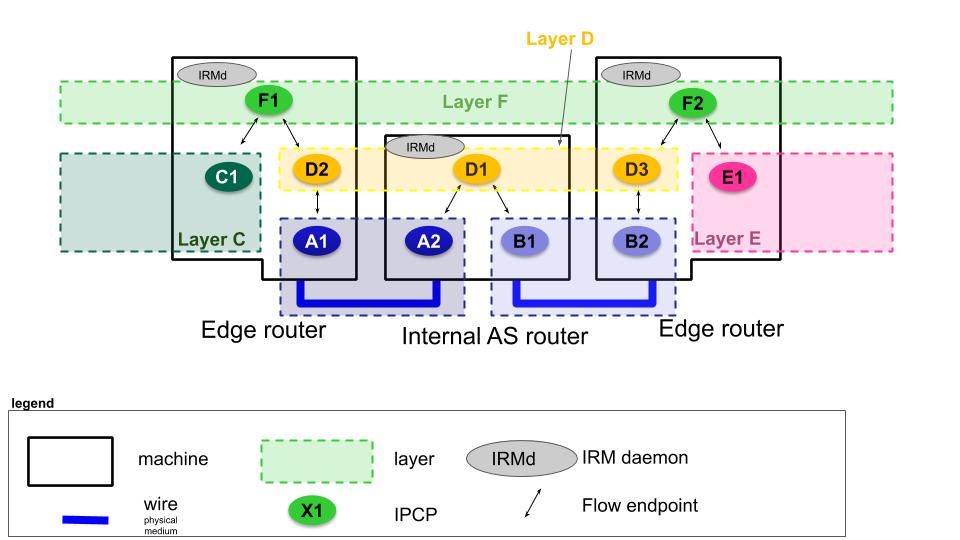Recursive layers
The most important structure in recursive networks are the layers, that are built op from elements called Inter-Process Communication Processes (IPCPs). (Note again that the layers in recursive networks are not the same as layers in the OSI model).

Now, the question is, how do we build these up these layers? IPCPs are small programs (think of small virtual routers) that need to be started, configured and managed. This functionality is usually implemented in some sort of management daemon. Current RINA implementations call it the IPC manager, Ouroboros calls it the IPC Resource Management daemon or IRMd for short. The IRMd lies at the heart of each system that is participating in an Ouroboros network, implementing the core function primitives. It serves as the entry point for the system/network administrator to manage the network resources.
We will describe the functions of the Ouroboros IRMd with the Ouroboros commands for illustration and to make things a bit more tangible.
The first set of primitives, create (and destroy), allow creating IPCPs of a given type. This just runs the process without any further configuration. At this point, that process is not part of any layer.
$ irm ipcp create type unicast name my_ipcp
$ irm ipcp list
+---------+----------------------+------------+----------------------+
| pid | name | type | layer |
+---------+----------------------+------------+----------------------+
| 7224 | my_ipcp | unicast | Not enrolled |
+---------+----------------------+------------+----------------------+
The example above creates a unicast IPCP and gives that IPCP a name (we called it “my_ipcp”). A listing of the IPCPs in the system shows that the IPCP is running as process 7224, and it is not part of a layer (”Not enrolled”).
To create a new functioning network layer, we need to configure the IPCP, using a primitive called bootstrapping. Bootstrapping sets a number of configuration optionss for the layer (such as the routing algorithm to use) and activates the IPCP to allow it to start providing flows. The Ouroboros command line allows creating an IPCP with some default values, that are a bit like a vanilla IPv4 network: 32-bit addresses and shortest-path link-state routing.
$ irm ipcp bootstrap name my_ipcp layer my_layer
$ irm ipcp list
+---------+----------------------+------------+----------------------+
| pid | name | type | layer |
+---------+----------------------+------------+----------------------+
| 7224 | my_ipcp | unicast | my_layer |
+---------+----------------------+------------+----------------------+
Now we have a single node-network. In order to create a larger network, we connect and configure new IPCPs using a third primitive called enrollment. When enrolling an IPCP in a network, it will create a flow (using a lower layer) to an existing member of the layer, download the bootstrapping information, and use it to configure itself as part of this layer.
The final primitive is the connect (and disconnect) primitive. This allows to create adjacencies between network nodes.
An example of how to create a small two-node network is given in tutorial 2